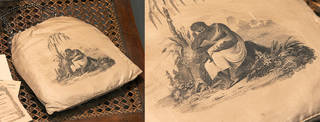In this trail Avril Horsford, one of our African Heritage Gallery Guides, explores the traumatic history that connects Britain and the Caribbean, resulting from the lucrative and brutal trade in enslaved Africans, taken to work on sugar plantations in the 17th century. These objects reveal the uncomfortable truths of enslaved labour and ownership, colonial island takeovers, and the profiteering of natural resources, alongside Britain's insatiable hunger for sugar. They convey emotive narratives around the racist legacy of enslavement, exploitation, colonialism, creolisation and migration that inform the reality of the British Caribbean experience that still exists today.
The trail starts in our Fashion Gallery, Room 40. Simply click on the links to find each object on our digital map.

Stop 1: Skirt suit worn by Dr Beryl Gilroy, early 1950s
Map link: Fashion, Room 40, Level 0

This brightly coloured skirt suit was made in Guyana for Dr Beryl Gilroy, a teacher who migrated from Guyana to Britain in 1951, to continue her studies in education. Although she was highly qualified, Dr Gilroy was denied a teaching job in London because of prejudices against her race and gender. Later in life, Beryl became a successful and eclectic author and editor, furthering her studies before returning to a trailblazing career in education. She became one of London's first Black headteachers in 1968.

Stop 2: Reticule, about 1827
Map link: Fashion, Room 40, Level 0

This reticule, or small bag, was made by the Female Society for Birmingham as part of their campaign to end enslavement. Founded in 1825, the Society was part of the British abolitionist movement, which existed alongside the British trade in enslaved Africans, millions of whom were transported to the Caribbean. Women were particularly involved in the movement, and society members worked hard to produce merchandise like this bag to fund their activities. The design, which shows a nursing mother caring for her baby, was deliberately chosen to challenge the stereotype of Black women as promiscuous, and stir donors to give generously to the Society's cause.

Stop 3: 'The Warrior' bracelet, 1974
Map link: Jewellery, Room 91, Level 2

Trinidadian jewellery designer Barbara Jardine was educated in England from the age of ten. She made this bracelet as part of her post-graduate degree show at the Royal College of Art. Mixing traditional materials with natural resources, including iridescent beetle shell, it evokes the horseshoe-shaped Manilla 'bracelets', which were traded as a form of currency during the colonial enslavement of Africans. For me, the traditional silver bracelets worn by millions of Caribbean people today are similar to these culturally iconic Manilla bracelets.

Stop 4: Portrait miniature of Henry Swinburne, 1775 – 80
Map link: Portrait Miniatures, Room 90a, Level 2

Henry Swinburne, an entrepreneur of noble birth, confidently straddled the formal, social and economic networks between Britain and the Caribbean. As a wealthy travel writer, Swinburne used his substantial inheritance to invest in the Caribbean, primarily Trinidad. Although he made a financial loss there, he gained respectability by morphing from beneficiary to benefactor, eventually becoming Commissioner of Trinidad in 1801. This portable 18th-century portrait miniature served to accentuate Swinburne's positive qualities, capturing his dignified pose and expensive clothes. It reminds me of how modern social media imagery is used today.

Stop 5: Toussaint Louverture print, 1802
Map: Europe 1600–1815, Room 1, Level -1

For conservation reasons, this object is kept inside a cabinet. Please ask a member of staff to open it for you.
The Black struggle against imperialism and colonialism has produced many freedom fighters. Like Nelson Mandela in South Africa years later, Toussaint Louverture was the most significant rebel leader of his time, not just in Haiti, but also across the Caribbean. Born into slavery, the charismatic and articulate Louverture led the Haitian independent movement to victory. This print, depicting him ready for battle, sword held high, served as a call-to-arms for his followers from the 1791 Slave Rebellion, which briefly established Haiti as a Black-governed French Protectorate.

Stop 6: Francis Williams, the Scholar of Jamaica, about 1745
Map link: Britain Galleries, Room 52, Level 1

Although not enslaved himself, Francis Williams, whose wealthy parents had been enslaved, was greatly affected by the impact of slavery. A Jamaican mathematician and classicist, his achievements are proudly showcased in this painting, where even the title emphasises his unique status as 'the Scholar of Jamaica'. After journeying to Britain and studying at Cambridge University, Williams' inheritance allowed him to live as an English gentleman, before he tried to gain political office in Jamaica. He lived with limited success in both cultures during a period of great social, cultural and racial upheaval.

Stop 7: Tortoiseshell combs and case, 1673
Map link: Britain Galleries, Room 56c, Level 1

In the 17th century entrepreneurial British adventurers from all levels of society journeyed to the Caribbean, with ambitions to make their fortunes from the emerging sugar industry there. This new 'Plantocracy' – the successful plantation owners who were regarded as the dominant class – commissioned luxury objects to promote their elevated status back home. Gifts symbolising success were made of exotic materials, and tortoiseshell items, like these combs, were particularly prized as the raw materials were unavailable in Britain, making them enviable tokens. We think these may have been commissioned by Lady Lynch, wife of the Governor of Jamaica.

Stop 8: Sugar box, 1683 – 84
Map link: Britain Galleries, Room 56c, Level 1

Although it was produced under brutal enslaved conditions in the Caribbean, wealthy British consumers were proud of their sugar, and considered it a valuable and precious commodity, even keeping it under lock and key from their servants. As well as storing sugar, an elegantly crafted object like this would have accompanied its aristocratic owner to the table. To convey the status of their owners, sugar boxes were often made from intricately decorated silver, in the expensive and sophisticated 17th-century style known as Chinoiserie.


